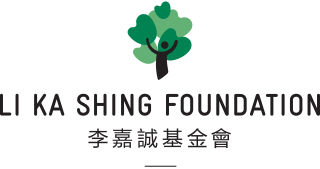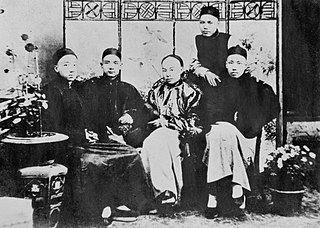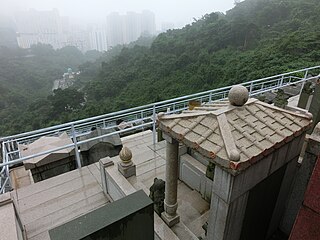
Sun Yat-sen was a Chinese statesman, physician, and political philosopher, who served as the provisional first president of the Republic of China and the first leader of the Kuomintang. He is called the "Father of the Nation" in the Republic of China, and the "Forerunner of the Revolution" in the People's Republic of China for his instrumental role in the overthrow of the Qing dynasty during the Xinhai Revolution. Sun is unique among 20th-century Chinese leaders for being widely revered in both China and Taiwan.

The University of Hong Kong (HKU) is a public research university in Hong Kong. Founded in 1911, its origins trace back to the Hong Kong College of Medicine for Chinese, which was founded in 1887. It is the oldest tertiary institution in Hong Kong. HKU was also the first university established by the British in East Asia.

Sun Yat-sen University, also known as Zhongshan University, is a public research university located in Guangzhou, Guangdong, China. It was founded in 1924 by and named after Sun Yat-sen, a revolutionary and the founder of the Republic of China. Its main campus, commonly referred to as the South Campus, is located in Haizhu District, Guangzhou, inheriting the campus from the former Lingnan University. The university has five campuses in the three cities of Guangzhou, Zhuhai and Shenzhen, and ten affiliated hospitals. It is a member of the nation's Double First Class University Plan, former Project 985, and Project 211 for leading research universities.

Queen's College, initially named The Government Central School in 1862 and later renamed Victoria College in 1889, is a selective sixth form college for boys with a secondary school attached. The first public secondary school founded in Hong Kong by the British colonial government, Queen's College obtained its present name in 1894 and is currently located at Causeway Bay, Hong Kong.

Aberdeen Street is a border street dividing Sheung Wan and Central on Hong Kong Island, Hong Kong. It ascends from Queen's Road Central to Caine Road in Mid-Levels. The street is named after George Hamilton-Gordon, 4th Earl of Aberdeen, Foreign Secretary at the time of the cession of Hong Kong Island to the United Kingdom in 1842.
Before the handover of Hong Kong to the People's Republic of China in 1997, medical education in this former British colony traditionally and exclusively followed the path of western medicine. Faculties of Medicine were modelled after those in the United Kingdom, and only doctors trained in western medicine were considered "formal" and "reliable." Chinese medicine practitioners had no formal status at that time. However, after the return of the territory to China, the practice of traditional Chinese medicine was further regulated and schools of Chinese Medicine were set up within some of the government funded tertiary institutions in Hong Kong. The first school of its kind, the School of Chinese Medicine at Hong Kong Baptist University, was established in 1998. Currently, there are two faculties with academic programmes in western medicine and three schools of Chinese Medicine in the city.
Modern medical education in Hong Kong started with the founding of the Hong Kong College of Medicine for Chinese in 1887. Currently, six institutes of higher education are engaged in the training of medical practitioners in Hong Kong.

The Dr Sun Yat-sen Museum is a museum in Central, Hong Kong. It is located in Kom Tong Hall, at 7 Castle Road, Central. After the preparation work undertaken by the Hong Kong Museum of History, the museum was opened on 12 December 2006, so as to commemorate the 140th birthday of the influential Chinese statesman.

Lyndhurst Terrace is a street in the Central area of Hong Kong. Built on a slope in southern Central district, the terrace links Hollywood Road and Wellington Street, at its intersection with Pottinger Street. In the middle it meets Gage Street, Cochrane Street and the Central–Mid-Levels escalators.

The Li Ka Shing Foundation is a Hong Kong-based charitable organization founded in 1980 by Hong Kong entrepreneur Li Ka-shing.

Sir Kai Ho, CMG, JP, MRCS, better known as Sir Kai Ho Kai, born Ho Shan-kai, was a Hong Kong barrister, physician and essayist in Colonial Hong Kong. He played a key role in the relationship between the Hong Kong local community and the British colonial government. He is remembered as a supporter of the Reform Movement and as a teacher of student Sun Yat-sen, who would become the founding father of the Republic of China. Kai Tak Airport, Hong Kong, was named after him and his son-in-law Au Tak, though he died in 1914, long before the idea of an aerodrome was first mentioned in 1925.

Sir James Cantlie was a British physician. He was a pioneer of first aid, which in 1875 was unknown: even the police had no knowledge of basic techniques such as how to stop serious bleeding and applying splints. He was also influential in the study of tropical diseases and in the debates concerning degeneration theory.

Li Shu-fan was a leader of the medical profession in Hong Kong and a member of the Legislative Council of Hong Kong.

The Four Bandits, Four Outlaws or the Four Desperados was a nickname given to a group of 4 young students in Hong Kong who were keen on discussing the current issues in China, and aspired to overthrow the Manchu-led Qing dynasty. The four bandits were Yeung Hok-ling, Sun Yat-sen, Chan Siu-bak and Yau Lit. "Yeung Yiu Kee" (楊耀記), Yeung's family shop located at 24 Gough Street in Hong Kong, used to be the meeting place of the bandits. One of the Four Bandits, Sun Yat-sen later became the leader of China Revolutionary Alliance and the first Provisional President of the Republic of China. At the Dr Sun Yat-sen Museum, statues made out of wax were made of the exact picture taken.

Chan Siu-bak (陳少白), born Chan Siu-man (陳紹聞), courtesy name Siu-bak (少白), art-named Kwai-shek (夔石), was a Chinese revolutionary from Sanwui, Kwangtung. He was one of the Four Bandits, together with Sun Yat-sen, Yau Lit and Yeung Hok-ling.

The Li Ka Shing Faculty of Medicine of the University of Hong Kong is a medical school which comprises several schools and departments that provide an array of tertiary programmes in medicine, nursing, pharmacy and chinese medicine. English is the medium of instruction in all of the classes while Chinese is also retained for the teaching of chinese medicine. It is located several kilometres away from the main campus of the university and is near the Queen Mary Hospital which is its main teaching facility and research base. Founded in 1887, it is also one of the oldest western medical schools in the Far East.
Dr William Hartigan was a physician for the Hongkong Shanghai Banking Corporation, co-founder of the Hong Kong College of Medicine for Chinese and a brother-in-law of Sir Thomas Jackson.

Gregory Paul Jordan was a British-Indian doctor and educator of Armenian descent. He served in various medical positions throughout colonial British Hong Kong, and was involved with various medical and educational institutions in the territory.

Hong Kong Buddhist Cemetery is a private cemetery located in Cape Collinson, on Hong Kong Island, Hong Kong. It is managed by The Hong Kong Buddhist Association (香港佛教聯合會). The cemetery was completed and opened in 1963.

Hong Kong Chinese Christian Churches Union Pok Fu Lam Road Cemetery or Hong Kong Chinese Christian Churches Union Pokfulam Road Cemetery is a cemetery in Pok Fu Lam, Hong Kong. It is managed by The Hong Kong Chinese Christian Churches Union. It lies on the slopes east of Victoria Road between Tung Wah Coffin Home and Pok Fu Lam Road, facing Sandy Bay.
















